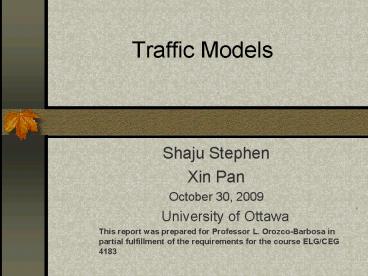Traffic Models - PowerPoint PPT Presentation
1 / 18
Title:
Traffic Models
Description:
Markov-Modulated Poisson Process (MMPP) Traditional Models. Autoregressive traffic models ... A Poisson process can be characterized as a renewal process. ... – PowerPoint PPT presentation
Number of Views:329
Avg rating:3.0/5.0
Title: Traffic Models
1
Traffic Models
- Shaju Stephen
- Xin Pan
- October 30, 2009
- University of Ottawa
- This report was prepared for Professor L.
Orozco-Barbosa in partial fulfillment of the
requirements for the course ELG/CEG 4183
2
Outline
- Introduction
- Improving the traffic
- Traffic characterization
- Traditional models
- Recent trends
- Comparison
- Questions
- References
3
Introduction
- Traffic model
- -Purpose
- -Key issues
- -Key terms
- -Importance
4
Improving the Traffic
- Bandwidth
- Queue size at routers
- Routing mechanisms
- Admission control
- Scheduling mechanisms
5
Traffic Characterization
- Measurement based
- Deterministic based
- Statistical based
6
Traditional Models
- Renewal traffic models
- Poisson Processes
- Bernoulli Processes
- Markov-based traffic models
- Markov-Modulated Processes (MMP)
- Markov-Modulated Poisson Process (MMPP)
7
Traditional Models
- Autoregressive traffic models
- Linear Autoregressive (AR) Processes
- Moving Average (MA) Processes
- Autoregressive Moving Average (ARMA) Processes
- Autoregressive Integrated Moving Average (ARIMA)
Processes
8
Poisson Processes
- Poisson model is the oldest traffic model.
- A Poisson process can be characterized as a
renewal process. - The superposition of independent Poisson
processes results in a new Poisson process whose
rate is the sum of the component rates.
9
Markov Model
- MMP is continuous-state, discrete-time process,
can model the workload arriving synchronously at
the system. - In MMPP, the interarrival time can be arbitrarily
distributed, and depend on both states straddling
each interarrival interval.
10
Markov Model
0.5
Head
0.5
I
0.5
0.5
0.5
0.5
Tail
11
Recent Trends
- TES traffic models (Transform-Expand-Sample)
- Self-similar traffic models
- Fractional Gaussian Noise (FGN)
- FARIMA model
12
Self-Similar Models
- Significance
- Causes
- Drawback
13
FARIMA Model
- Describe both SR and LR
- Model identification
- Parameter estimation
- Diagnostic checking
14
Comparison
- Traditional traffic models
- analytically tractability in the corresponding
queuing systems. - generally capture short-range dependence.
- Recent traffic models
- are difficult to solve analytically.
- can describe both SRD and LRD.
15
Comparison
16
Questions
- 1)What is the purpose of a traffic model?
- 2)Name a scheme used in traffic characterization
- 3)Self-similar models do not describe long range
dependence (True/false)
17
Questions
- 4) Name two traditional traffic models
- 5) What is the computational complexity of FARIMA
model - a) O(N) b)
O(N2) - 6) What are the essential differences between
Poisson Model and Self-Similar Models
18
References
- A. Neidhardt and J. L. Wang, The Concept of
Relevant Time Scales and Its Application to
Queuing Analysis of Self-similar Network
Traffic, Proc. IEEE Intl. Conf. On Network
Protocols, Oct. 1996. - D. Bertsekas and R. Gallager. Data Networks.
Prentice-Hall, Second Edition, 1992. - M. E. Crovella and A Bestavros, Self-similarity
in world wide web traffic evidence and possible
causes, IEEE/ACM Transactions on Networking,
1997. - V. Paxson and S. Floyd, Wide Area Traffic The
Failure of Poisson Modeling, IEEE/ACM
Transactions on Networking, 1995.































